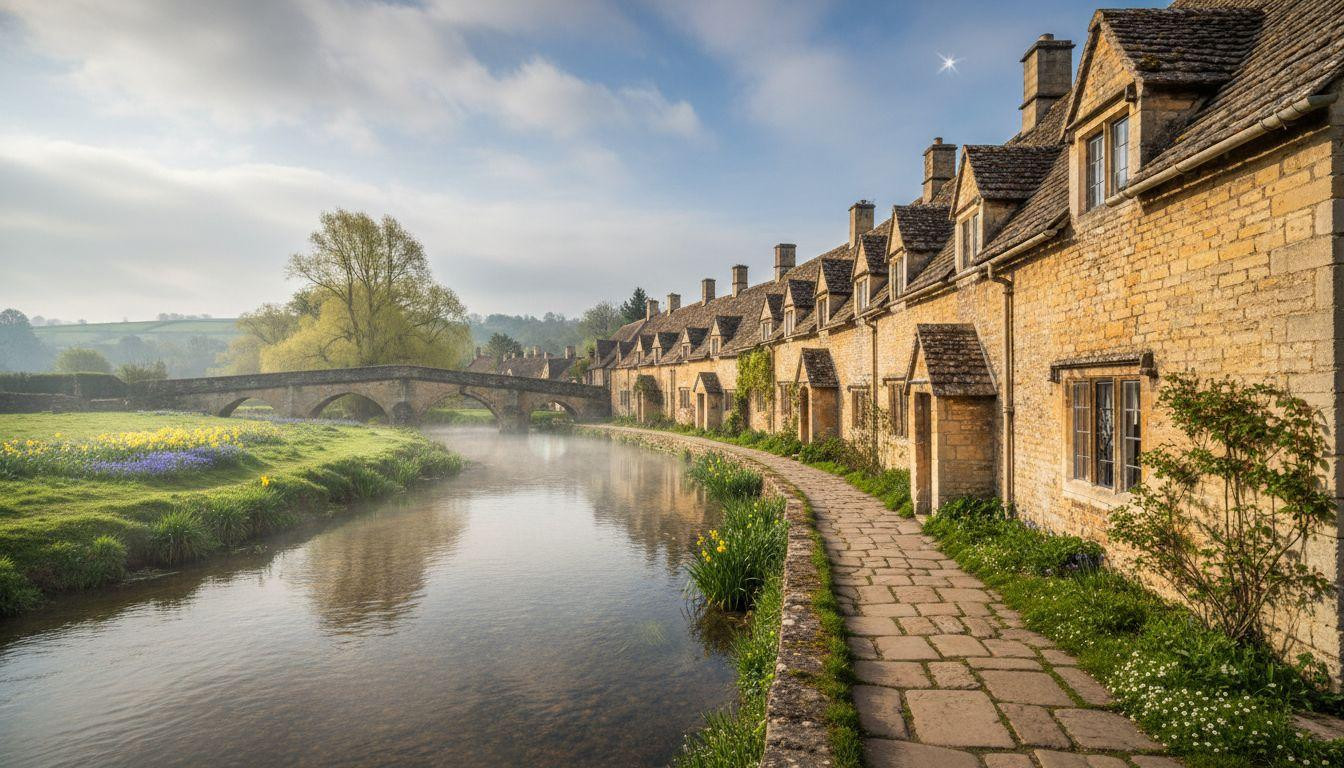Spring mornings in Bibury arrive with a quiet magic. At 6:47 AM, soft mist rises from the River Coln. Golden light touches honey-colored stone cottages along Arlington Row. The medieval village of 600 residents awakens slowly. Tour buses won’t arrive for two hours. This window belongs to kingfishers and early walkers.
The scene feels pulled from a painting. Cool air carries the scent of river water and wildflowers. Stone bridges reflect in still water. Morning fog softens sharp edges of 17th-century cottages. This is England as it existed 400 years ago.
Where medieval England still wakes slowly
Bibury sits in the Cotswolds Area of Outstanding Natural Beauty. Oxford lies 31 miles east. The village preserves its wool trade origins from 1380. Arlington Row began as a monastic wool store.
Weavers’ cottages replaced the original structure in the 17th century. William Morris called this area “the most beautiful village in England” in the 1800s. The National Trust now protects these Grade I listed buildings. Similar medieval preservation efforts protect villages across Europe.
The village operates on authentic rhythms. Residents emerge around 7:30 AM for morning walks. Local tourism boards confirm 300,000 visitors arrive annually. Peak crowds gather between 10 AM and 4 PM during summer months.
When light and mist create magic
Spring delivers optimal conditions for atmospheric photography. April through June brings morning mist formations. Temperature differences between cool river water and warming air create perfect fog conditions. The phenomenon peaks between 6:30 AM and 8:00 AM.
The River Coln’s morning theater
Mist rises from water heated to 50°F overnight. Spring air temperatures hover around 45°F at dawn. The differential creates ethereal fog layers. Kingfishers break the silence with sharp calls. Swans glide through reflected cottage images.
Three stone bridges offer viewing angles. The furthest upstream provides classic Arlington Row compositions. Morning light arrives from the southeast. Soft illumination warms limestone walls gradually. Photographers capture magic impossible at midday.
Stone that glows from within
Cotswold limestone contains natural honey tones. Morning sun activates golden hues in the rock face. Steep stone-tiled roofs catch first light. Mullioned windows frame interior warmth. Similar limestone architecture defines England’s medieval heritage sites.
Texture contrasts define the visual experience. Rough limestone walls meet smooth river surfaces. Ancient stones show 650 years of weathering. Morning dew highlights surface details invisible in harsh daylight.
Living among 775 years of history
Dawn walks along Arlington Row reveal authentic village life. Residents appreciate early visitors who respect the peaceful atmosphere. The pathway remains public despite National Trust ownership. Rack Isle water meadows extend beyond the cottages.
Walking Arlington Row at dawn
The riverside path opens at all hours. Spring wildflowers bloom in May and June. Daffodils emerge first, followed by bluebells. Belted Galloway cattle graze nearby meadows. Locals call them “Oreo cows” for their distinctive black and white markings.
Village sounds replace tourist chatter before 8 AM. River water moves over ancient stones. Birds call from cottage gardens. Remote medieval villages across Britain offer similar tranquil morning experiences. Footsteps echo off stone walls.
Beyond the famous cottages
St. Mary’s Church dates to Saxon times. Karl Parsons designed a stained glass window featured on a 1992 Royal Mail Christmas stamp. The Bibury Trout Farm operates with 10°C spring-fed water year-round. England’s oldest working trout farm produces 10 million rainbow trout annually.
The Catherine Wheel pub serves traditional British fare. Rooms cost $95-$190 per night in 2025. Fresh trout dishes highlight local ingredients. Scotland’s remote coastal villages offer similar atmospheric morning experiences. Village life continues beyond tourist hours.
The feeling you can’t photograph
Morning silence in Bibury defies description. River water moves without urgency. Stone walls hold centuries of stories. Cool air carries scents from blooming gardens. Spring temperatures reach 59°F by 8 AM.
The experience transcends visual beauty. Ancient rhythms persist in this protected space. Visitors understand why residents guard these morning hours. Tourism pauses between 6 AM and 9 AM. Authentic village life emerges in this window.
Visitor surveys conducted in 2025 reveal morning hours receive highest satisfaction ratings. Travelers describe “stepping back in time” during misty dawn visits. The village reveals its true character before crowds arrive.
Your Questions About Bibury answered
When should I visit for morning mist?
April through June offers optimal conditions. Arrive by 6:30 AM for best mist formations. Weather patterns favor calm, cool nights followed by warming mornings. Village parking costs $8 per day. Walk 500 meters from the main car park to Arlington Row.
How much does visiting Bibury cost?
Budget guesthouses start at $95 per night. Mid-range hotels cost $130-$240 nightly. Meals average $15-$32 at local pubs. Bibury Trout Farm entry costs $11. Total daily expenses range $150-$300 per person including accommodation.
Is Bibury different from Castle Combe?
Bibury features the flowing River Coln while Castle Combe lacks water elements. Bibury receives 300,000 annual visitors compared to Castle Combe’s 150,000. Distance from Oxford: Bibury 31 miles, Castle Combe 22 miles. Bibury maintains more authentic village life with 600 residents versus Castle Combe’s primarily tourist-focused economy.
By 8:30 AM the first tour buses arrive. Parking fills rapidly during summer months. The magical window closes as day-trippers discover England’s most beautiful village. Morning mist dissipates, leaving memories of medieval silence.
